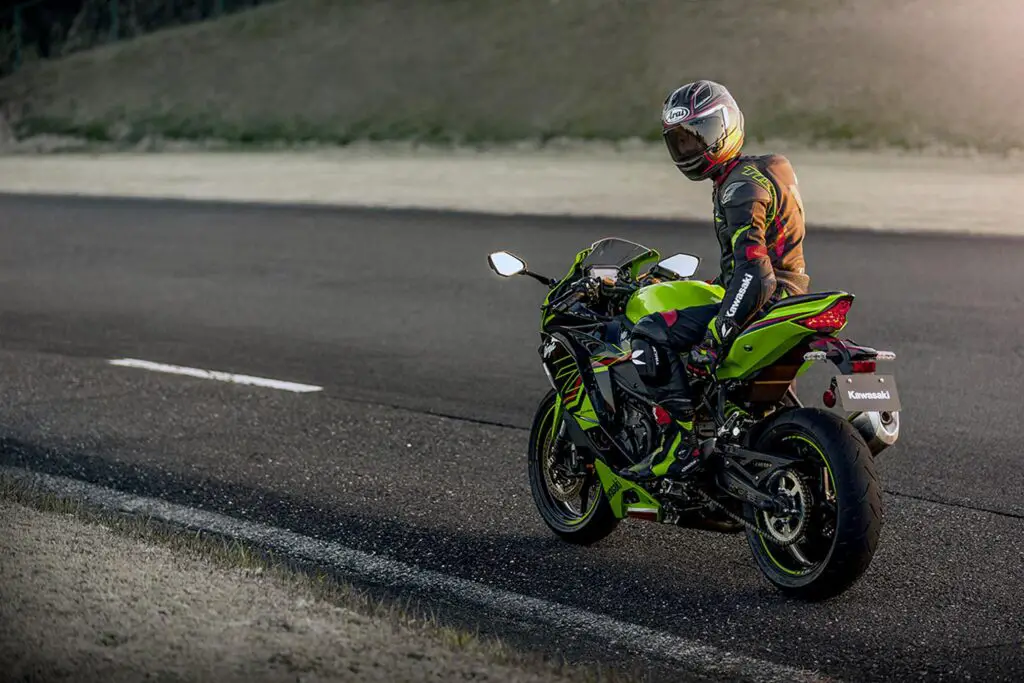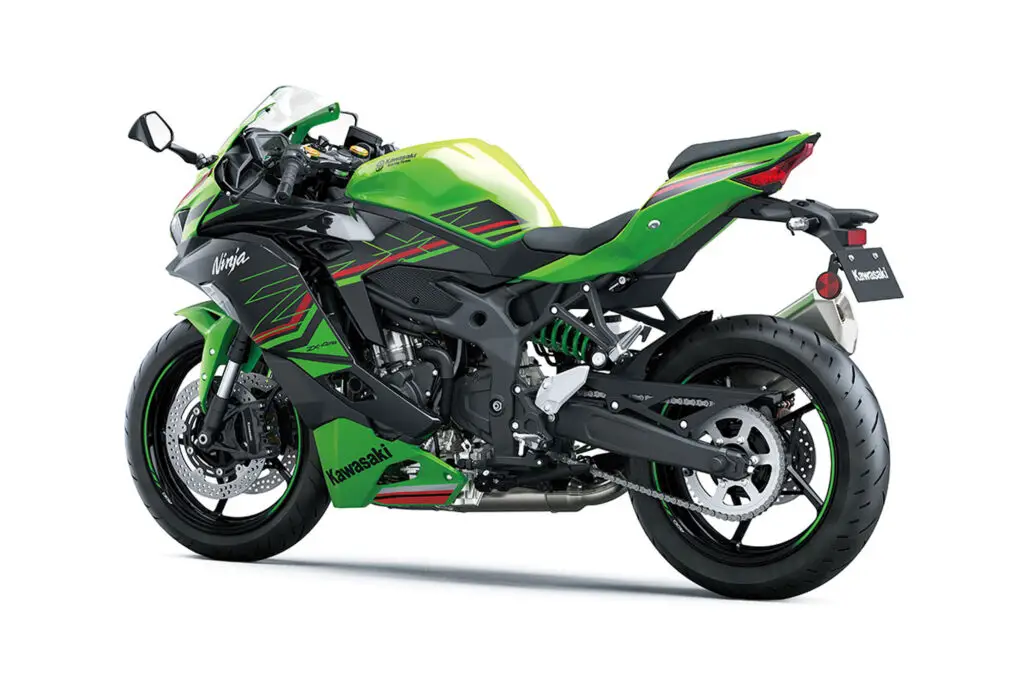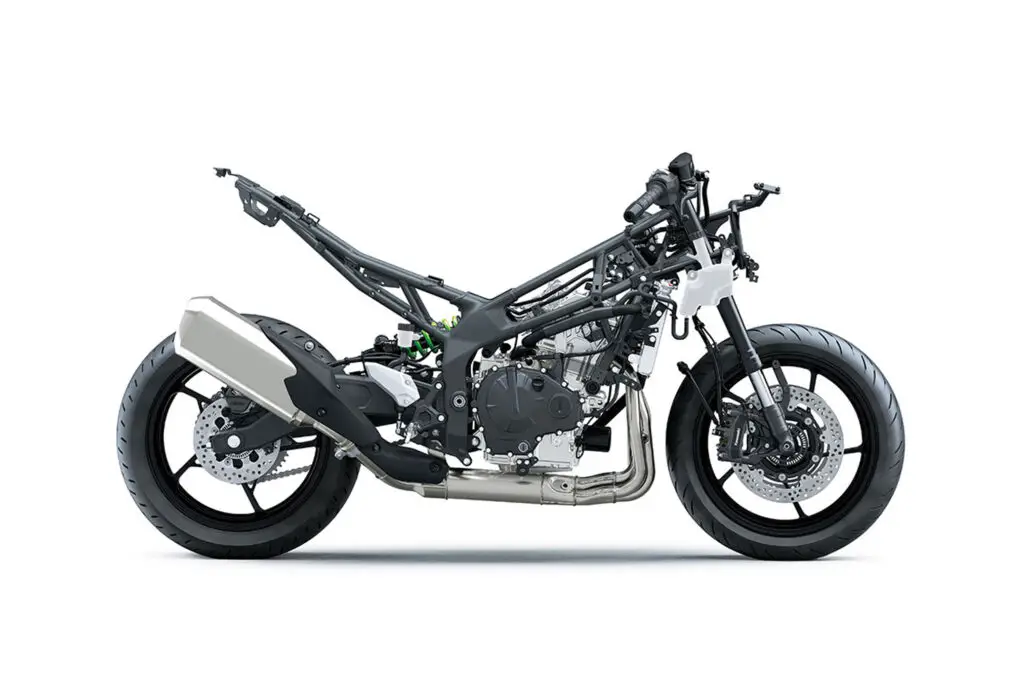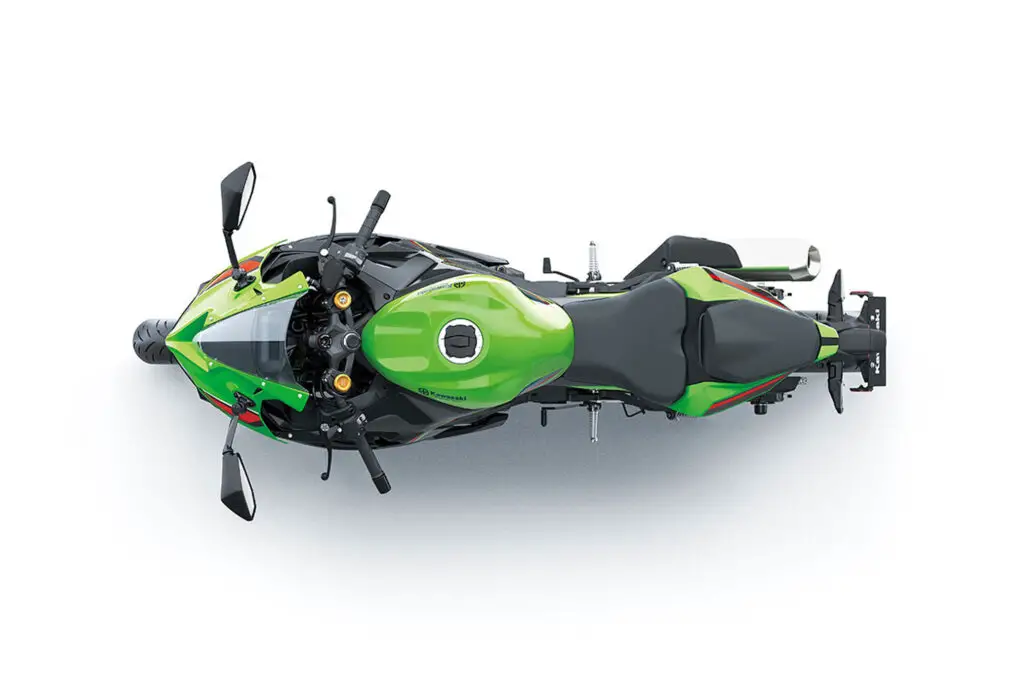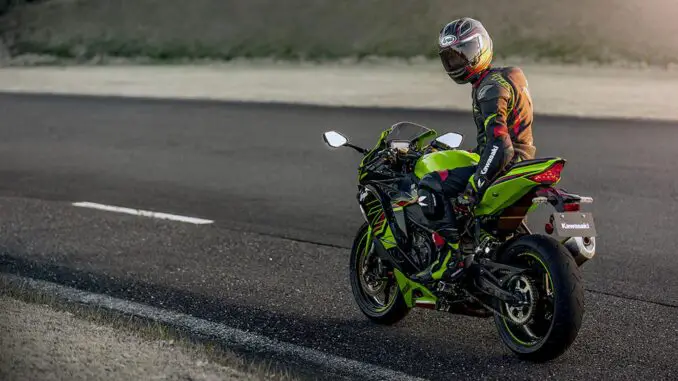
Contents: Review – Key Features – Features & Benefits – Specifications
Contents: Review – Key Features – Features & Benefits – Specifications
2023 Kawasaki Ninja ZX-4RR: NINJA REVOLUTION.
Introducing the 2023 Kawasaki Ninja ZX-4RR…
Clad in sharp Ninja styling, the Ninja 400 delivers greater performance than its predecessor care of all-new engine and chassis that are more powerful and significantly lighter.
But like the Ninja 300 that preceded it, this Ninja model possesses much more than high performance. Not only does the Ninja 400 offer stunning, high-quality looks, its stronger engine performance, light, predictable handling and relaxed, sporty riding position make it both fun and easy to ride
Twin LED Headlamps
In addition to contributing to the Ninja 400’s sharper looks, slim LED headlamps (each featuring low and high beams, as well as a LED position lamp) are highly visible and offer significantly increased brightness.
Powerful, Rider-Friendly Parallel Twin
The Ninja 400’s 399 cm3 engine delivers a balance of performance and controllability. The engine offers increased performance at all rpm compared to its predecessor, with good power feeling. Smooth, predictable response contributes to an easy-to-control engine character. Thanks to its efficient design, the compact, lightweight engine has a size on par with 250cc engines.
High-Grade Cockpit
The Ninja 400 is equipped with a sophisticated cockpit, featuring a large analogue tachometer flanked by warning lamps on one side, and a gear position indicator and multi-function LCD screen on the other.
Largest Brake Disc in Class
Measuring ø310 mm (the same disc size used on the Ninja ZZR1400), the Ninja 400’s semifloating front disc offers sure stopping power. A rigid new front brake master cylinder helps eliminate ineffective (idle) stroke, contributing to controllability, while carefully selected brake hose dimensions and material contribute to brake touch. Featuring the latest ABS unit from Nissin, the most compact and lightweight available.
Relaxed, Sporty Riding Position
Relaxed rider triangle accommodates a wide range of rider sizes and riding situations. Compared to some other models (whose somewhat extreme riding position compromises comfort), the elevated handle position and slightly foot-forward footpeg position put the rider in a position to control the bike while also offering rider comfort.
Easy Reach to the Ground
While seat height is 785 mm, the slim design of both the seat and the rear of the engine gives riders an unobstructed line for their feet to reach the ground.
Sharp Ninja Styling
Head-turning looks have always been a forte of Ninja models, regardless of displacement. The new Ninja 400 boasts futuristic new Ninja styling inspired by the mighty Ninja H2. The largevolume bodywork attracts attention, and gives the impression of a larger machine. This impression is reinforced by the high-class design and superb fit and finish, which are comparable to bikes from a larger-displacement class.
Lightweight Trellis Frame
The Ninja 400 features a trellis frame similar in design to that of the Ninja H2. Kawasaki’s advanced dynamic rigidity analysis was used to ensure optimum rigidity with light weight. The engine is rigidmounted and used as a stressed member. The frame design contributes significantly to the bike’s low curb mass.
2023 Kawasaki Ninja ZX-4RR Totalmotorcycle.com Key Features
- NEW All-new 399cc liquid-cooled, 4-stroke, in-line four cylinder engine
- NEW World Superbike-inspired chassis design
- NEW Dual front disc brakes
- NEW High-performance suspension
- NEW Ergonomics for control and comfort
- NEW Fierce Ninja ZX styling
- NEW 3” TFT color instrumentation with circuit mode
- NEW Smartphone connectivity via RIDEOLOGY THE APP
- NEW All LED lighting
- NEW Integrated riding modes
- NEW Dual-direction Kawasaki Quick Shifter (KQS)
- HIGH-REVVING INLINE FOUR-CYLINDER ENGINE
- KAWASAKI QUICK SHIFTER
- WORLD SUPERBIKE-INSPIRED CHASSIS DESIGN
- HIGH GRADE SUSPENSION
- DUAL FRONT DISC BRAKES WITH MONOBLOC CALIPERS
- SPORTY YET COMFORTABLE RIDING POSITION
- TFT COLOR INSTRUMENTATION
- High-performance suspension
- Assist & Slipper clutch
- Dual front disk brakes
- Integrated Riding Modes
- Power Mode Selection
- TFT color instrumentation with circuit mode
- Smartphone Connectivity via RIDEOLOGY THE APP
- All LED lighting
- Exclusive Kawasaki Racing Team (KRT) color & graphics
2023 Kawasaki Ninja ZX-4RR Totalmotorcycle.com Features and Benefits
ENGINE
The Ninja ZX-4RR boasts an all-new 399cc liquid-cooled, 4-stroke, in-line four cylinder engine that delivers exhilarating performance and fun-to-ride power. Developed with feedback from other Kawasaki Ninja ZX supersport machines, the all-new engine found on the Ninja ZX-4RR features a quick-revving nature with a direct throttle response that combines strong low-mid range torque for city riding and high-rpm power that can be enjoyed when riding on the track. As riders roll on the throttle, they are rewarded with a satisfying surge of acceleration that is complemented by the distinct intake and exhaust notes of a Kawasaki in-line four cylinder engine.
The liquid-cooled, DOHC, 16-valve, 399cc in-line four cylinder engine features a bore and stroke of 57.0 x 39.16mm and packs impressive power and strong torque. The bore and stroke contributes to the impressive top-end power. A high-spec ECU is similar to that found on the Kawasaki Z H2, which allows for the use of Kawasaki’s latest electronics. Electronic Throttle Valves (ETV) with 34mm throttle bodies provide smooth, natural engine response by enabling the ECU to control the volume of both the fuel (via the injectors) and the air (via throttle valves) delivered to the engine. Additionally, they facilitate the use of Kawasaki electronic rider support systems such as integrated riding modes with traction control, selectable power modes, and a dual-direction Kawasaki Quick Shifter (KQS) that allows riders to feel “at one” with their machine.
Intake port interiors are sand cast using fine sand, which results in a smooth finish. Similar to the Ninja ZX-10R, the intake port exits have been machined in two stages, first along with the valve seats and then again at an inclined angle, to create a straighter path for intake air as it enters the combustion chamber. The straighter and wider path for the intake air promotes a smoother flow and a greater volume of fuel-air mixture that contributes to the engine’s high performance. Lightweight forged camshafts contribute to the high-revving and high-rpm performance.
Large 22.1mm intake valves are complemented by 19mm exhaust valves, flowing a great volume of air for excellent high-rpm performance. Triple-rate valve springs accommodate the valves and add to the Ninja ZX-4RR’s high-rpm performance. A narrow valve angle helps combustion efficiency as well as achieves a compact engine design. The combustion chambers are precision machined to high tolerances – a production technique that is limited to Kawasaki’s high-performance premium models.
Lightweight cast aluminum pistons contribute to low reciprocating weight for quick-climbing revs. The piston skirts have a molybdenum coating that increases durability. The piston crowns were designed to develop compression, which contributes to the 12.3:1 compression ratio that is found on the Ninja ZX-4RR and optimized to allow the use of regular gasoline while achieving strong performance. The piston’s wide bore facilitates the use of the large intake and exhaust valves for greater air flow, while their short stroke adds to the high-rpm performance. Utilizing an aluminum die-cast cylinder with an open-deck design, excellent heat dissipation and low engine weight is achieved.
In order to reduce mechanical loss and vibration, Kawasaki engineers carefully selected the connecting rod ratio, while a special carburizing treatment was used on the connecting rods to improve durability and reduce weight. Thanks to the crankshaft’s light flywheel mass, a low moment of inertia was reached, contributing to a quick-revving engine character and direct throttle response. A deep oil pan ensures that the oil pump inlet is always submerged, blocking air from being ingested, even during hard acceleration and deceleration while sport or track riding.
ADVANCED ENGINE COOLING
With the Ninja ZX-4RR engine designed for high performance, Kawasaki engineers placed a great emphasis on the engine’s cooling system in order to achieve optimum performance. The water jackets on the cylinder head were carefully designed and long-reach spark plugs offer greater contact with the water jacket, helping to prevent engine knocking. A large, 30-row radiator provides efficient engine cooling to handle the Ninja ZX-4RR’s performance capabilities. Side air ducts are built into the fairings to direct cool air towards the engine and promote heat dissipation that greatly contributes to engine performance. Innovative Kawasaki technology like the patented radiator fan cover that is located behind the radiator directs hot air out to the sides and away from the rider, improving rider comfort. The heat management system was designed using CFD analysis and controls the flow of air, helping keep the tank, frame, and other parts that contact the rider cooler, further increaseing rider comfort.
RAM AIR DUCT INTAKE SYSTEM
The Ram Air duct system is a trademark feature on Kawasaki’s Ninja ZX models. It’s a centrally positioned intake that improves filling efficiency and increases engine performance. Following a layout that is similar to that of the Ninja H2, the Ram Air duct is routed to the left of the front fork on its way to the airbox. This contributes to a duct with a highly efficient airflow, enabling cool, high-pressure air from the front of the bike to be ingested. Engine performance is increased at all rpm thanks to the increased pressure and cooler air. Additionally, the design is extremely effective at preventing water from entering the airbox while riding in the rain. The large Ram Air duct has “Ram Air” stamped into it, which is visible to the rider and adds to the Ninja ZX-4RR’s high-performance look and feel. Intake funnels, consisting of 60mm and 40mm lengths, contribute to efficient filling and produce a flat torque curve with smooth power delivery. The downdraft intake creates a shorter, more direct path for intake air to enter the cylinder, improving cylinder-filling efficiency and increasing engine power, especially at high rpm.
EXHAUST
The header pipes and collector pipe layout were built with inspiration from the Ninja ZX-6R. Joint pipes link the headers, contributing to a strong power output while meeting emissions and sound regulations. A traditionally styled, long silencer produces a clear, racy exhaust note that is distinct to that found on a Kawasaki in-line four cylinder engine. The collector pipe features triple catalyzers to ensure emissions are met and their position makes it easy to add a slip-on muffler.
TRANSMISSION & CLUTCH
Complementing the high-performance 399cc engine is a smooth-shifting six-speed transmission that is designed to shine in all riding situations. It’s especially well suited for riders accelerating out of corners when sport or track riding and features a dual-direction Kawasaki Quick Shifter (KQS). Developed through Kawasaki’s racing efforts, the Ninja ZX-4RR is fitted with an Assist & Slipper Clutch that uses two types of cams (an assist cam and slipper cam), offering two functions that are not available on a standard clutch. When the engine is operating at normal rpm the assist cam functions act as a self-serve mechanism, pulling the clutch hub and operating plate together to compress the clutch plates. This allows the total clutch spring load to be reduced, resulting in a lighter clutch lever pull when operating the clutch. When excessive engine braking occurs, the slipper cam comes into play, forcing the clutch hub and operating plate apart. This relieves pressure on the clutch plates to reduce back torque and help prevent the rear tire from hopping or skidding.
ELECTRONICS
KAWASAKI TRACTION CONTROL (KTRC)
Kawasaki’s advanced KTRC system provides both enhanced sport riding performance and peace of mind under certain conditions to negotiate low-traction surfaces with confidence. Three selectable modes offer progressively greater levels of intrusion that cut fuel and ignition to help maintain traction and forward drive as well as suit the riding situation and rider preference. The system uses a number of parameters to get an accurate real-time picture and adapt accordingly. Mode 1 is the least intrusive and designed with sport riding in mind, Mode 2 intervention occurs earlier offering a balance of sport riding support and rider confidence, and Mode 3 is the most intrusive for navigating low-traction conditions. In addition to the three modes, the rider can elect to turn the system OFF.
POWER MODES
Power Modes offer riders an easily selectable choice of engine power delivery to suit riding conditions or preferences. In addition to Full Power mode, one (Low) alternate mode in which maximum power is limited and throttle response is milder is provided.
INTEGRATED RIDING MODES
All-inclusive modes that link KTRC and Power Mode allow riders to easily set traction control and power delivery to suit a given riding situation. Riders can choose from three settings (Sport, Road, Rain) or a manual setting (Rider). In the manual Rider mode, each of the systems can be set independently.
KAWASAKI QUICK SHIFTER (KQS)
Adding to its impressive list of high-performance features, the Ninja ZX-4RR comes equipped with dual-direction KQS. The KQS allows ultra-quick upshifts and downshifts without the need to use the clutch, resulting in a more enjoyable experience and quicker lap times. Designed for more effective sport riding, KQS can also be used on the street when the engine is above 2,500 rpm.
TFT COLOR INSTRUMENTATION
The 4.3” all-digital TFT color instrumentation gives the cockpit a high-tech, high-grade appearance and features a Circuit Mode that allows lap timing and shows track-related information in a more prominent and easier-to-view layout. The high-grade color LCD screen features TFT (thin-film transitory) technology, delivering a high level of visibility. Selectable background and text colors can be chosen to suit light or dark conditions and screen brightness automatically switches between five levels to suit available light.
Display functions include a digital speedometer, digital bar-style tachometer, gear position indicator, shift indicator (tachometer flashes), fuel gauge, odometer, dual trip meters, current and average fuel consumption, remaining range, average speed, riding time, coolant temperature, clock, battery voltage, lap timer (Circuit Mode only), Kawasaki service reminder, oil change reminder, integrated riding mode, KTRC and power mode indicators, smartphone call and mail notices, Bluetooth indicator, economical riding indicator, and KQS indicator.
Circuit mode can be toggled for use at track days and changes the display to make information for track riding more visible. This includes showing the lap time in the center with large text so that it can easily be ready while riding. The gear position and tachometer display is also more visible along the top when above 10,000 rpm, giving riders a clear view of the information needed when working towards faster lap times on the track.
RIDEOLOGY THE APP
Bluetooth technology built into the instrument panel enables riders to connect to their motorcycle wirelessly. Using RIDEOLOGY THE APP*, a number of instrument functions can be accessed, logged, and reviewed contributing to an enhanced motorcycling experience. The following information can be viewed:
- Vehicle Info – Information such as fuel gauge, odometer, maintenance schedule and more can be viewed via the smartphone
- 2. Riding Log – GPS route information as well as vehicle running information can be logged and viewed via the smartphone
- 3. Mobile Phone Notices – When a call or email is received by the smartphone, this is indicated on the instrument display
- Tuning / General Settings – General instrument display settings such as preferred units, date, date format, and more can be adjusted via the smartphone
The app can also be used when away from the motorcycle. When riding (with the app ON), the bike and smartphone are always connected and riding log data is being recorded by the app. After your ride, the latest riding information is stored by the app and may be viewed on the smartphone. Any changes made via the app while the engine is off, or while out of range, will be implemented as soon as the ignition is turned on and the smartphone is in range with the app ON.
* RIDEOLOGY THE APP is not intended for use during vehicle operation. Only use RIDEOLOGY THE APP when the vehicle is not being operated and it is safe to do so.
CHASSIS
The Ninja ZX-4RR delivers light maneuverability when riding around town, however, its high-level supersport character shines when out sport riding on backroads or at the racetrack. Utilizing feedback derived directly from Kawasaki Racing Team’s (KRT) efforts in the FIM World Superbike Championship, Kawasaki engineers carefully selected key chassis components to achieve excellent rigidity balance. Formed from high-tensile steel, the trellis frame features various pipe diameter thicknesses with a swingarm pivot section. Kawasaki’s advanced dynamic rigidity analysis was used to ensure the required balance of strength and chassis flex.
Key chassis dimensions, such as center of gravity position, swingarm pivot position, engine axis positions, and the caster angle were inspired by Kawasaki’s World Superbike Ninja ZX-10RR, bringing World Superbike chassis design to the 400cc class. The long-style swingarm is made from high-tensile steel and allows the bike’s front-rear weight distribution to be set for the perfect balance of nimble handling and composed chassis behavior. An arch design on the right side of the swingarm delivers the required balance of rigidity and flex, enabling the silencer to be positioned as centrally as possible while adding to the Ninja ZX-4RR’s stylish, sporty looks.
SUSPENSION
To complement the optimal rigidity balance of the chassis, the Ninja ZX-4RR front end is held up by a 37mm inverted front fork that features Showa’s SFF-BP (Separate Function Fork – Big Piston) technology. This advanced fork offers both racetrack performance and everyday usability. The technology is similar to that on the Ninja ZX-6R, while the spring rate and damping characteristics were developed specifically for the Ninja ZX-4RR. The front fork provides smooth action at the initial part of the stroke that contributes to excellent composure under braking. A large-diameter damping piston is used in the SFF-BP fork, which is much larger than that used in a cartridge-type fork. This allows oil inside the fork to act on a much larger surface area and damping pressure to be reduced while ensuring the same damping force. By reducing the damping pressure, it allows the slide pipe to move more smoothly, which is especially noticeable during the initial part of the stroke. This design allows for greater control as the fork begins to compress and a smooth transition as the Ninja ZX-4RR’s weight shifts forward when reducing speed, offering greater chassis stability on corner entry and a planted feel when braking. The fork settings were designed to accommodate a wide range of riding situations, from the city to the racetrack. The spring preload is adjustable and can be tailored to suit the rider’s preference, which is the first use of adjustable SFF-BP in the 400cc class.
At the rear of the Ninja ZX-4RR, horizontal back-link rear suspension mounted to a Showa BFRC (Balance Free Rear Cushion) Lite shock can be found. The shock is similar to that found on the Ninja ZX-10R and has been specially tuned for the Ninja ZX-4RR. Its excellent movement at the start of the stroke ensures comfort in day-to-day riding as well as a planted feel when riding on the track, while linear damping characteristics provide a stable, solid feel and peace of mind for the rider in a wide variety of situations. Additionally, it offers adjustable compression and rebound damping as well as adjustable spring preload so that riders can fine-tune the rear end to suit their riding preferences. The horizontal back-link rear suspension positions the shock unit and linkage above the swingarm and out of the way from engine and exhaust heat. A firm rear shock feel achieves a planted feel that is reassuring during sport riding, while also offering ample absorption for ride comfort when riding around town.
WHEELS & BRAKES
In order to stop the powerful Ninja ZX-4RR, a pair of 290mm semi-floating front discs handle the stopping duties up front and are gripped by 4-piston radial-mount monobloc calipers. The calipers feature different diameter pistons with the upper piston measuring 32mm and the lower piston 30mm. Dual front discs were chosen for additional stopping power and the monobloc calipers help achieve a firm initial touch. Brake pad selection contributes to both brake force and braking controllability.
At the rear, a 220mm disc is slowed by a single-piston caliper that is powered by a 38mm piston. The master cylinder, caliper, brake pedal, and brake pad material were carefully selected for a balance of stopping power and control. Equipped with ABS, the Ninja ZX-4RR features Nissin’s latest ABS control unit that has been specially developed to deliver precise control and is the most compact and lightweight unit available.
Stylish star-pattern five-spoke wheels contribute to the bike’s overall lightweight and their high rigidity improves handling. The wheels also contribute to the bike’s light, nimble appearance. Dunlop Sportmax GPR-300 radial tires are mounted on the front and rear, offering high grip in both wet and dry conditions and contributing to agile handling and excellent riding comfort. A 120/70ZR17 tire is used on the front and 16-/60ZR17 is fitted on the rear.
ERGONOMICS
To take full advantage of the Ninja ZX-4RR’s nimble, supersport-style handling is a naturally aggressive riding position that is more forward-leaning than that found on the Ninja 400. The riding position on the Ninja ZX-4RR offers a good balance of wind protection and aerodynamics that enable the rider to tuck in to get out of the wind, while still maintaining a relaxed feel. A slim design of the fuel tank between the rider’s legs promotes good contact with the bike and a low design on the top of the fuel tank facilitates the rider getting into a tucked position. A firm seat cushion offers both sports potential and comfort. The seat makes it easy for riders to shift their weight during sport or track riding and increases comfort on long rides. Supersport-style footpegs give the rider a direct feel and good controllability when sport riding. An adjustable brake and clutch lever each offer five position settings that allows the rider to set them to suit their hand size and preference.
STYLING
The aggressive Ninja styling of the Ninja ZX-4RR was designed to deliver a fierce look that contains its power and explosive action, benefitting the most powerful machine in the 400cc class. Prominently located at the center of the upper cowl, the Ram Air intake is a trademark feature on Ninja ZX models, setting the machine apart from its competition. It’s stamped with “Ram Air”, leaving a reminder of the bike’s high performance. A sharp chin spoiler further contributes to the strong Ninja family image. The supersport-style low fuel tank and minimalist tight-fitting bodywork that wraps around the in-line four engine gives the Ninja ZX-4RR a compact, high-class look. Sharply angled lines contribute to a lightweight image that reflects the bike’s nimble supersport-style handling. Side air ducts in the fairings provide a blend of form and function, directing cool air into the engine and adding aggressive lines for a stylish design. The upswept angle of the slim, race-style tail cowl puts off a lightweight appearance and the rear flap can easily be removed for track days.
Twin LED headlights help the Ninja ZX-4RR stand out and provide excellent illumination, while LED front turn signals are built into the fairings. The LED taillight was inspired by the Ninja ZX-10R, adding a high-grade touch to the rear of the motorcycle. Both the license plate bulb and rear turn signals are LED, completing the full LED package.
ACCESSORIES
A wide range of Kawasaki Genuine Accessories (KGA) are available and allow riders to personalize their Ninja ZX-4RR motorcycles. This includes a sport seat with firm urethane cushioning that makes it easier to feel the rear wheel traction during sport riding sessions and a USB outlet that provides a convenient charging point and is accessible under the seat. Other accessories such as a pillion seat cover, frame slider, tank pad, radiator screen, and meter protector are also available.
2023 Kawasaki Ninja ZX-4RR – Totalmotorcycle.com USA Specifications/Technical Details
US MSRP Price: $ NA USD
Canada MSRP Price: $10,999 CDN
Europe/UK MSRP Price: £ See Dealer GBP (On The Road inc 20% Vat)
NA
2023 Kawasaki Ninja ZX-4RR – Totalmotorcycle.com Canadian Specifications/Technical Details
| Engine | 399cc, liquid-cooled, 4-stroke, DOHC 16-valve in-line four |
| Bore x Stroke | 57.0 x 39.1 mm |
| Compression Ratio | 12.3:1 |
| Fuel System | Fuel injection: ø34 mm x 4 |
| Ignition | Digital |
| Starting | Electric |
| Lubrication | Forced lubrication, wet sump |
| Transmission | 6-speed, return |
| Clutch | Wet multi-disc, manual |
| Final Drive | Chain |
| Frame | Trellis, high-tensile steel |
| Front Suspension / Wheel Travel | ø37 mm inverted fork (SFF-BP) with spring preload adjustability and top-out springs / 120 mm (4.7 in) |
| Rear Suspension / Wheel Travel | Horizontal Back-link, BFRC lite gas-charged shock with piggyback reservoir, compression and rebound damping and spring preload adjustability, and top-out spring / 124 mm (4.9 in) |
| Rake / Trail | 23.5° / 97 mm |
| Steering Angle (L/R) | 35° / 35° |
| Front Tire | 120/70ZR17M/C (58W) |
| Rear Tire | 160/60ZR17M/C (69W) |
| Front Brakes | Dual semi-floating ø290 mm discs with radial-mount, monobloc, opposed 4-piston calipers |
| Rear Brake | ø220 mm disc with single-piston caliper |
| Dimensions (L x W x H) | 1,990 x 765 x 1,110 mm (78.3 x 30.1 x 43.7 in) |
| Wheelbase | 1,380 mm (54.3 in) |
| Road Clearance | 135 mm (5.3 in) |
| Seat Height | 800 mm (31.5 in) |
| Curb Mass** | 188 kg (414 lb) |
| Fuel Capacity | 15 litres |
| Instrumentation | Full-colour TFT screen with digital speedometer, digital bar-style tachometer, gear position indicator, shift indicator (tachometer flashes), fuel gauge, odometer, dual trip meters, current and average fuel consumption, remaining range, average speed, riding time, coolant temperature, clock, battery voltage, lap timer (Circuit Mode only), Kawasaki service reminder, oil change reminder, integrated Riding Mode, KTRC, and Power Mode indicators, smartphone call and mail notices, Bluetooth indicator, Economical Riding Indicator, and KQS indicator |
| Warranty | 12 months |
| Kawasaki Protection Plus | 12 / 24 / 36 / 48 months |
2023 Kawasaki Ninja ZX-4RR – Totalmotorcycle.com European Specifications/Technical Details
Engine
Engine type
Liquid-cooled, 4-stroke Parallel Twin
Displacement
399 cm³
Bore x stroke
70 x 51.8 mm
Compression ratio
11.5:1
Valve system
DOHC, 8 valves
Fuel system
Fuel injection: Ø 32 mm x 2
Starting System
Electric
Lubrication
Forced lubrication, wet sump
Performance & Transmission
Maximum power
33.4 kW {45 PS} / 10,000 rpm
CO2 emission
91 g/km
Maximum torque
37 N•m {3.8 kgf•m} / 8,000 rpm
Transmission
6-speed
Final drive
Sealed chain
Primary Reduction Ratio
2.219 (71/32)
Gear Ratios 1st
2.929 (41/14)
Gear Ratios 2nd
2.056 (37/18)
Gear Ratios 3rd
1.619 (34/21)
Gear Ratios 4th
1.333 (32/24)
Gear Ratios 5th
1.154 (30/26)
Gear Ratios 6th
1.037 (28/27)
Final reduction ratio
2.929 (41/14)
Clutch
Wet multi-disc, manual
Brakes & Suspension
Brakes, front
Single semi-floating 310 mm petal discs. Caliper: Single balanced actuation dual piston
Brakes, rear
Single 220 mm petal disc. Caliper: Dual-piston
Suspension, front
41mm telescopic fork
Suspension, rear
Bottom-Link Uni-Trak, gas-charged shock with adjustable preload
Frame & Dimensions
Frame type
Trellis, high-tensile steel
Trail
92 mm
Wheel travel front
120 mm
Wheel travel rear
130 mm
Tyre, front
110/70R17 M/C 54H
Tyre, rear
150/60R17 M/C 66H
Tyre, rear
150/60R17 M/C 66H
L x W x H
1,990 x 710 x 1,120 mm
Wheelbase
1,370 mm
Ground clearance
140 mm
Fuel capacity
14 litres
Seat height
785 mm
Curb mass
168 kg
Manufacturer Specifications and appearance are subject to change without prior notice on Total Motorcycle (TMW).


